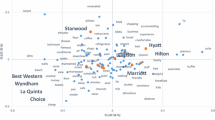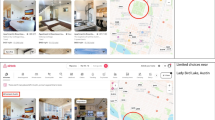Abstract
There is huge untapped potential for the application of Large Language Models in the fields of marketing and advertising. In this work, we describe an approach to automate the generation of brand territory maps, a visualization used by advertising strategists to understand how a brand is perceived by consumers and differentiated from its competitors. We collect a Household Item data set with product reviews to exemplify our approach. We elicit customer perceptions from ChatGPT with regards to certain dimensions, viz., esteem, reliability, modernity, quality and relevance. By analyzing customer reviews using this Large Language Model, we show that it is possible to get a broader view of how consumers perceive specific aspects of certain products or brands in an automated fashion. We perform an empirical evaluation to compare the brand territory maps generated using our approach and those generated by humans. We find that (1) Human responses have significantly more variation than those by ChatGPT; (2) Making small adjustments to the ChatGPT prompt can result in stark differences in results; (3) Our approach is extremely cost effective compared to that of using humans to generate brand territory maps; and that (4) The brand territory maps generated using our approach are comparable to those generated by humans.











Similar content being viewed by others
Data Availability Statement
The data set created in this article is available for other researchers at: https://www.kaggle.com/datasets/luisaf1126/falabella-reviews/data.
References
BBC News Mundo: Cuáles son las 10 marcas más valiosas de américa latina, https://www.bbc.com/mundo/noticias-43874472
Cruz Tarrillo JJ, Haro Zea KL, Soria Quijaite JJ. Revisión sistemática: situación actual de la personalidad de marca para el posicionamiento estratégico. Tendencias. 2022;23(1):315–40.
Deldjoo Y. Understanding biases in chatgpt-based recommender systems: provider fairness, temporal stability, and recency. ACM Trans Recommender Syst. 2024;2:5.
Devlin J, Chang M, Lee K, Toutanova K. BERT: pre-training of deep bidirectional transformers for language understanding. CoRR abs/1810.04805 2018, http://arxiv.org/abs/1810.04805.
Díez D, Castiblanco Laurada C, Ríos Cardona C. Territorios de marca para el desarrollo sostenible: arquetipos en investigación y creación con grupos de interés de chec grupo epm 2022.
Eriksson T, Bigi A, Bonera M. Think with me, or think for me? on the future role of artificial intelligence in marketing strategy formulation. TQM J. 2020;32(4):795–814.
Gonzalez-Oñate C, Martínez Bueno S. La marca territorio como elemento de la comunicación: Factor estratégico del desarrollo turístico en cuenca/the brand territory as a communication: Strategic factor in tourism development in cuenca 2013.
Joshi A, Kale S, Chandel S, Pal DK. Likert scale: explored and explained. Br J Appl Sci Technol. 2015;7(4):396–403.
Kannangara L, Harsha S, Isuru T, Wijesiriwardhane C, Wijendra DR, Kishara J. Artificial intelligence-based business strategy for optimized advertising. In: 2021 3rd International Conference on Advancements in Computing (ICAC). 2021;pp. 234–239. IEEE.
Katyal SK, Kesari A. Trademark search, artificial intelligence, and the role of the private sector. Berkeley Technol Law J. 2020;35(2):501–88.
Kietzmann J, Paschen J, Treen E. Artificial intelligence in advertising: How marketers can leverage artificial intelligence along the consumer journey. J Advert Res. 2018;58(3):263–7.
Lacárcel FJS. Main uses of artificial intelligence in digital marketing strategies linked to tourism. J Tour Sustain Well-being. 2022;10(3):215–26.
Li Y. Graph-of-thought: Utilizing large language models to solve complex and dynamic business problems. arXiv preprint arXiv:2401.06801 2024.
Lita RL, Osuna MTB. De la marca comercial a la marca territorio. Recerca: Revista de pensament i anàlisi 2005;pp. 87–100.
Liu V, Chilton LB. Design guidelines for prompt engineering text-to-image generative models. In: Proceedings of the 2022 CHI Conference on Human Factors in Computing Systems. 2022;pp. 1–23.
Martínez IJM, Terrón JMA, Cobarro PHS. Smart advertising: Innovación y disrupción tecnológica asociadas a la ia en el ecosistema publicitario. Rev Latina de Comunicación Social. 2022;80:21.
OpenAI AJ, Adler S, Agarwal S, Ahmad L, Akkaya I, Aleman FL, Almeida D, Altenschmidt J, Altman S, Anadkat S, et al. GPT-4 Technical Report. 2023. arxiv. org/abs/2303.08774
Raffel C, Shazeer N, Roberts A, Lee K, Narang S, Matena M, Zhou Y, Li W, Liu PJ. Exploring the limits of transfer learning with a unified text-to-text transformer. J Mach Learn Res. 2020;21(140):1–67.
Ray PP. Chatgpt: a comprehensive review on background, applications, key challenges, bias, ethics, limitations and future scope. Internet Things Cyber-Phys Syst. 2023;3:121–54.
Ribeiro MBRSP, et al. A comunicação publicitária-a relação das estratégias de mensagem com os referentes culturais: o caso da publicidade televisiva portuguesa e os seus referentes culturais. Ph.D. thesis, Comunicación audiovisual e publicidade 2018
Robbert K, Penn C, Wall J. Use cases of large language models in marketing analytics. Appl Market Anal. 2023;9(3):249–69.
Rodríguez C, Chávez RMA, Kuri LC. Diagnóstico sobre la relación de la influencia emocional en el comportamiento del consumidor. Ciencias Administrativas. 2019;1:23–32.
Rodriguez-Sarmiento LF, Galpin I, Sanchez-Riaño V. Mapping brand territories using chatgpt. In: International Conference on Applied Informatics. 2024;pp. 31–46. Springer.
Sabharwal D, Sood R, Verma M. Studying the relationship between artificial intelligence and digital advertising in marketing strategy. J Content Commun Commun. 2022;16:118–26.
Sánchez-Riaño V, Baez LCS, Garcia-Bedoya O, Sojo-Gomez JR. Variables para la fase diagnóstica de un software piloto de planeación estratégica. Vis Rev. International Visual Culture Review/Revista Internacional de Cultura Visual 9(Monográfico), 2022;1–15.
Soni V. Large language models for enhancing customer lifecycle management. J Emp Soc Sci Stud. 2023;7(1):67–89.
Sood S, Pattinson H. Marketing education renaissance through big data curriculum: developing marketing expertise using ai large language models. Int J Innov Econ Dev. 2023;8(6):23–40.
Stone M, Aravopoulou E, Ekinci Y, Evans G, Hobbs M, Labib A, Laughlin P, Machtynger J, Machtynger L. Artificial intelligence (ai) in strategic marketing decision-making: a research agenda. Bottom Line. 2020;33(2):183–200.
Swaminathan V, Schwartz HA, Menezes R, Hill S. The language of brands in social media: Using topic modeling on social media conversations to drive brand strategy. J Interact Mark. 2022;57(2):255–77.
Vaswani A, Shazeer N, Parmar N, Uszkoreit J, Jones L, Gomez AN, Kaiser Ł, Polosukhin I. Attention is all you need. Adv Neural Inf Process Syst. 2017;30:8.
Wang Y, Lin J, Yu Z, Hu W, Karlsson BF. Open-world story generation with structured knowledge enhancement: a comprehensive survey. arXiv preprint arXiv:2212.04634 2022.
Wankhade M, Rao ACS, Kulkarni C. A survey on sentiment analysis methods, applications, and challenges. Artif Intell Rev. 2022;55(7):5731–80.
Xie D, He Y, et al. Marketing strategy of rural tourism based on big data and artificial intelligence. Mob Inf Syst. 2022;20:22.
Zhao WX, Zhou K, Li J, Tang T, Wang X, Hou Y, Min Y, Zhang B, Zhang J, Dong Z, et al. A survey of large language models. arXiv preprint arXiv:2303.18223 2023.
Author information
Authors and Affiliations
Contributions
Luisa Rodriguez-Sarmiento contributed with conceptualization, methodology, coding, evaluation and paper writing. Ixent Galpin contributed with conceptualization, paper writing and supervision. Vladimir Sánchez-Riaño contributed with contributed with conceptualization, paper writing and supervision
Corresponding author
Ethics declarations
Conflict of interest
On behalf of all authors, the corresponding author states that there is no Conflict of interest.
Consent to participate
Informed consent was obtained from all individual participants included in the study.
Additional information
Publisher's Note
Springer Nature remains neutral with regard to jurisdictional claims in published maps and institutional affiliations.
Rights and permissions
Springer Nature or its licensor (e.g. a society or other partner) holds exclusive rights to this article under a publishing agreement with the author(s) or other rightsholder(s); author self-archiving of the accepted manuscript version of this article is solely governed by the terms of such publishing agreement and applicable law.
About this article
Cite this article
Rodriguez-Sarmiento, L.F., Sanchez-Riaño, V. & Galpin, I. Leveraging Large Language Models for Navigating Brand Territory. SN COMPUT. SCI. 5, 1070 (2024). https://doi.org/10.1007/s42979-024-03408-w
Received:
Accepted:
Published:
DOI: https://doi.org/10.1007/s42979-024-03408-w




